Please refer to Transport in Plants Class 11 Biology notes and questions with solutions below. These revision notes and important examination questions have been prepared based on the latest Biology books for Class 11. You can go through the questions and solutions below which will help you to get better marks in your examinations.
Class 11 Biology Transport in Plants Notes and Questions
Points To Remember
Translocation (Long distance tr·ansport) : Transport of substances in plants over longer distances through the vascular tissue (Xylem and Phloem) The transport of water and mineral in Xylem is unidirectional while transport of organic and mineral nutrients in phloem is multi-directional.
Means of transport (Short distance tr·ansport) : The transport of material into and out of the cells is carried out by a number of methods. These are diffusion, facilitated diffusion and active transport.
(i) Diffusion: Diffusion occurs from region of higher concentration to region of lower concentration across the permeable membrane. It is passive and slow process. No energy expenditure takes place.
Factors affecting diffusion : Permeability of membrane, Temperature, pressure, gradient of concentration and the size of substances.
(ii) Facilitated diffusion : The diffusion of hydrophilic substances along the concentration gradient through fixed membrane transport protein without involving energy expenditure. For this the membrane possess aquarporins and ion channels. No ATP energy is utilized in this process.
Porins-The proteins that form huge pores in the outer membranes of the plastids, mitochondria and some bacteria which allow the small size molecules to pass through.
Aquaporins- Proteins that facilitate diffusion of water molecules through/ across the plasma membrane of cell.

Transport Proteins-They are present in the membrane. They allow the passage of substances through membrane.
(i) Carrier Proteins-They bind to the particular solute particle to be transported and deliver these to other side of membrane.
(ii) Channel Proteins-Ion Channel-They are specific for different ions like K+, Cl–, NO–3, PO3-4, Mg2+
Water Channel- Surrounded by eight proteins called aqua protein and allow passage of water or water soluble substance.
(iii) Active transport : Active transport is carried by the movable carrier proteins (pumps) of membrane. Active transport uses energy to pump molecules against a concentration gradient from a low concentration to high concentration (uphill-transport). It is faster than passive transport.
Different Transport Mechanisms

- Water potential—(ψw)–Greater the concentration of water in a system, greater is its kinetic energy and greater is the water potential. It is measured in pascal (Pa). or mega pascal.
- If two systems are in contact, then there is movement of water from the solution with higher potential to lower water potential.
- Solute potential—(ψs)–Magnitude of lowering of water potential, when a solute is added to the water.
- Pressure Potential—(ψp)—Magnitude of increase of water potential, when pressure greater than atmospheric pressure is applied to pure water or a solution.
- Water potential of pure water is zero (0).
- Solute potential is always negative (–) and pressure potential is always positive (+).
ψw = ψs + ψp - Osmotic Pressure-External pressure applied to prevent the diffusion of water. It depends upon solute concentration.
- Numerically, osmotic pressure is equal to osmotic potential. Osmotic pressure has positive (+) sign. Osmotic potential has negative (–) sign.
Turgor Presure-Due to osmotic entry of water, the protoplasm of a plant cell presses the cell wall towards the outside with a force, it is called Turgor Pressure.
Diffusion Pressure-The pressure exerted by the tendency of the particles to diffuse from the area of higher concentration to lower concentration. It is directly proportional to the concentration of particles of diffusing substance.
Osmosis : Osmosis is movement of solvent or water molecules from the region of their higher diffusion pressure or free energy to the region of their lower diffusion pressure of free energy across a semipermeable membrane.
Water molecules move from higher water potential to lower water potential until equilibrium is reached.
Plasmolysis : Process of shrinkage of protoplast in a cell due to exosmosis in hypertonic solution. If a plasmolysed cell is placed in water or a hypotonic solution it becomes turgid.
Hypotonic solution : The external solution which is more dilute than thecytoplasm.
Hypertonic solution : The external solution, which is more concentrated than the cytoplasm.
Isotonic solution :When the external solution balances the osmotic pressure of the cytoplasm.
Casparian strip :It is the tangential as well as radial walls of endodermal cells having the deposition of water impermeable suberin.
Imbibition : Imbibition is the phenomenon of absorption of water by the solid particles of an adsorbent causing it to enormously increase in volume without forming a solution.
Some examples of Imbibition :
(i) If a dry piece of wood is placed in water, it swells and increases in its volume.
(ii) If dry gum or pieces of agar-agar are placed in water, they swell and their volume increases.
(iii) When seeds are placed in water they swell up.
(iv) Swelling of wooden door during rainy season.
Conditions essential for imbibition
1. Water potential gradient between the surface of the adsorbent and the imbibed liquid, is essential.
2. Affinity between the adsorbent and the imbibed liquid.
Transport of water in plants :Water is absorbed by root hairs by diffusion. Then water moves upto xylem by two pathways-apoplast and symplast pathway.
Apoplast Pathway-Movement occurs through the intercellular spaces or walls of the cell, without entering the cytoplasm. This movement is fast. In roots, movement of water occurs via apoplast except at the carparian strip, most of water enters through apoplast.
Symplast Pathway-Water enters the cell through cell membrane and travels intercellularly through plasmodesmata. This movement is slow. At casparian strip region water moves through symplast.

Ascent of Sap – Upward movement of water in the form of dilute solution of mineral ions from roots to the top aerial parts of plants through tracheary elements of xylem against the gravitational force is called ascent of sap. It involves two theories-
(i) Cohesion-Tension-transpirtation pull theory.
(ii) Root pressure theory.
(1) Cohesion-Tension-transpiration pull theory-
(i) Continuity of water column-The transport of water to the top of trees occurs through xylem vessels. The forces of adhesion and cohesion maintain a thin and unbroken column of water in the capillaries of xylem vessels through which it travels which is travels upward. Water is mainly pulled by transpiration from leaves.
(ii) Transpiration Pull-Transpiration accounts for loss of99% of water in the form ofwatervapours the surface ofleaves. The loss is mainly through stomata.
- Pull of water as a result of tension created by transpiration is the major diving force of water movement upward in a plant.
Three physical properties of water which affect the ascent of xylem sap due to transpiration pull.
(iii) Cohesion force or Tensile strength of water-
- Cohesion-Mutual attraction between water molecules.
- Adhesion-Attraction of water molecules to polar surface.
- Surface tension-Attraction of water to each other in liquid phase to a greater extent than to water in gaseous phase.
(2) Root pressure Theory : A hydrostatic pressure existing in roots which pushes the water up in xylem vessels upto certain height to herbaceons plant.
Guttation: The water loss in its liquid phase in the form of water droplets at night and early morning through special openings of vein near the tip of leaves. These opening are called hydathodes.
Transpiration :The loss of water through stomata of leaves and other aerial parts of plants in form of water vapours.
Factors affecting transpiration :Temperature, light, relative humidity, wind speed, number and distribution of stomata, water status of plant, canopy structure.
Significance of transpiration-Advantages-Helps in ascent of sap removal of excess water, cooling effect, distribution of mineral salts, supply water for photosynthesis.
Disadvantages – May cause reduced growth, wilting (loss of turgidity), reduced yield and waste of energy.
Since there are advantages as well as disadvantages of transpiration so-‘Transpiration is called a necessary evil’.
Opening and closing of stomata-Mechanism of opening and closing of stomata involves two steps-
(i) Change to the turgidity of gaurd cells.
(ii) Orientation of cellulose microfibrils in the cell wall of gaurd cells.
Endosmosis – When a cell is placed in water or hypotonic solution, water enters into the cell. This in called endosmosis. Due to it the volume of cell increases and it creates turgor pressure.
Exosmosis – When a cell is placed in hypertonic solution, water comes out of the cell, this is called exosmosis. It decreases volume of the cell.
Uptake and transport ofmineral nutrients – Ions are absorbed by the roots by passive and active transport. The active uptake of ions require ATP energy. Specific proteins in membranes of root hair cells activity pump ions from the soil into the cytoplasm of epidermal cells and then xylem. The further transport of ions to all parts of the plant is carried through the water stream. Older dying leaves export much of their mineral content to younger leaves. Elements phosphorus, sulphur, nitrogen and potassium are most readily mobilised.
Mass flow: Mass flow is the movement of substances (water, minerals and food) in bulk from one point to another as a result of pressure differences between two points.
The pressure or mass flow Hypothesis :


Mycorrhiza — A mycorrhiza is a symbiotic association of a fungus with a root system. The fungal hyphae absorb mineral ions and water from the soil, and provide them to the roots of plant, in turn the roots provide sugars and nitrogen containing compounds to the mycorrhizae.
Transpiration and Its
Types Transpiration The loss of water in the form of water vapours from the leaves and aerial parts of plant is called transpiration.
Types of Transpiration
• Stomatal transpiration- Occurs through stomata
• Cuticular transpiration- Occurs through surface of stem and leaves
• Lenticular transpiration- Occurs through lenticels
Occurs mainly through openings called stomata.
Stomata are the minute openings found in the epidermal layer of the leaves. A stoma is surrounded by two bean shaped guard cells which regulate its opening and closing.
Stomatal Transpiration
In plants, water is absorbed through the roots, This absorbed water has to be transported throughout the plant’s body for various physiological functions. It rises up in the stem through xylem and reaches the tissues of leaves through veins. The mesophyll cells of the leaves have their surfaces exposed to the intercellular spaces. Some amount of water forms a thin layer over these surfaces. The water from this film gets evaporated and form water vapours. These water vapours can diffuse through the intercellular space and reach the sub stomatal space and finally escape through stomata.
Regulation of Stomatal Transpiration
• Stomata:
• Open in the day and close during the night
• Also contribute in the exchange of O2 and CO2
• Opening and closing of stomata is influenced by the turgidity of the guard cells.
• Inner walls of the guard cells (towards stomatal opening): Thick and elastic
• When turgidity increases within two guard cells flanking each stomatal pore, the thin outer walls bulge out, and the inner walls assume a crescent shape.
• Radial orientation of microfibrils in the cell wall of the guard cells makes it easier for the stoma to open.
• When turgidity decreases within the guard cells, the inner walls regain their original shape, the guard cells become flaccid and stoma closes.
• Based on the distribution of stomata, 2 types of leaves:
• Dorsiventral: More number of stomata on the lower surface of leaves; found in dicots.
• Isobilateral: Equal number of stomata on both sides of leaves; found in monocots.
A partly physical and vital process controlled by internal and external factors of leaves
Factors Affecting Transpiration and Its Significance
Factors affecting Transpiration The factors affecting transpiration can be classified into two categories:
• External Factors
• Internal Factors
External Factors:
• Light: During the day time stomata is open and facilitates transpiration.
• Wind Speed: Rate of transpiration increases with the speed of wind.
• Humidity: Rate of transpiration decreases with increase in humidity.
• Temperature: High temperature results in more transpiration.
• Atmospheric pressure: Decreased atmospheric pressure increases the transpiration.
• Carbon dioxide: Increase in level of CO2 causes decrease in transpiration.
Internal Factors: Transpiration decreases when water content of the leaves decreases due to insufficient absorption by the root.
Adaptations in Plants To Reduce Excessive Transpiration
• Sunken stomata
• Less stomata
• Narrower leaves
• Loss of leaves
• Reduced exposed surface
• Thick cuticle
Significance Of Transpiration
• Suction force: It provides transpiration pull which is responsible for the upward movement of water in tall plants.
• Cooling effect: Evaporation causes cooling. Hence, transpiration helps plants in hot sunny days.
• Distribution of water and minerals: Since leaves are present at the tips of all branches, transpiration helps to draw water and minerals towards them, and thus helps in their distribution through out the plant’s body.
Transpiration affects Climate
• Most of the plants on a daily basis loses litres of water that is released in the atmosphere.
• The released water increases moisture in atmosphere that brings rain.
Relationship of Transpiration with Photosynthesis
• Process of photosynthesis requires water. Xylem provides water to the site of photosynthesis (leaves).
• As the water evaporates, in order to maintain a thin film of water over the cells, water is pulled from the xylem to the leaves.
• Also, due to the lower concentration of water in the atmosphere, water diffuses into the atmosphere to create a pull.
• Actively photosynthesising plants need more water, and availability of water can be a limiting factor for photosynthesis.
• C4 photosynthetic pathway makes sure that the maximum CO2 is fixed with minimum loss of water. For same amount of CO2 fixed, a C4 plant loses only half the amount of water lost by a C3 plant.
Importance of Transpiration
• Creates transpiration pull for transport
• Supplies water for photosynthesis
• Transports minerals from soil to all parts of a plant
• Cools the surface of the leaves (due to the evaporation of water)
• Keeps the cells turgid; hence, maintains their shape
Experiments Demonstrating Transpiration and Methods of Its Measurement
Experiments Demonstrating Transpiration
Experiment 1 Take a well watered medium sized plant. Cover the plant with a polythene bag. Tie its mouth near its base and pack it properly. Leave the plant out in sunlight for a few hours.
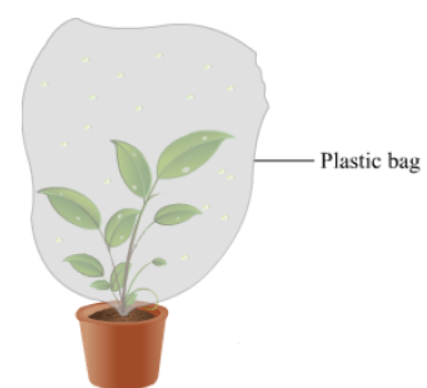
You will observe small droplets of water on the inner side of polythene bag. This is because of the water vapours given out by the leaves. When the water vapours given out condense, they form water droplets. This exhibits transpiration process in plants.
Experiment 2 Take three bell jars and name them A, B and C. In jar A, take a small, well watered
potted plant, with broad leaves. Now, cover the pot completely with a polythene bag and tie it properly to prevent escape of water vapours from pot.
In jar B, repeat the same procedure as for jar A and add a dry piece of cobalt chloride paper into the jar.
In jar C, just take the piece of dry cobalt chloride paper without the plant.
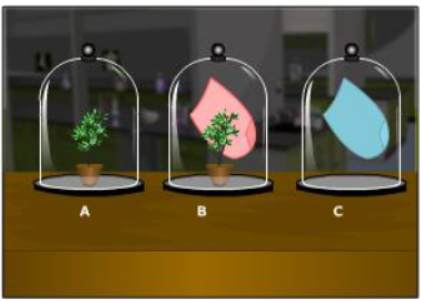
After sometime, you will observe that
• Jar A has water droplets, as water vapours condense on its inner walls.
• Jar B shows similar condensation along with change in colour of cobalt chloride paper from blue to pink.
• In jar C no colour change can be seen. This jar was used as a control to show that no moisture is present in air.
• This shows that transpiration has occurred.
Measurement of Transpiration
Transpiration can be measured through a number of methods. Here, we will discuss about some of them.
• Weighing Method:
• Take a small plant and weigh it on a weighing machine. Now cover the soil surface and pot completely so that it does not lose water by evaporation. Weigh the plant again after some time. You will observe some loss in the weight of the plant. This is due to the water loss by transpiration. The loss in weight can be measured using a weighing machine. This indicates volume of water loss can be compared with loss in weight by the weighing machine.
• Another Weighing Method:
• Take a test tube filled with water and insert a leafy shoot in it. Pour some oil on the surface to prevent loss of water by evaporation. Put the set up in a small beaker and
weigh it. Leave the test tube in a test tube stand for few hours. Now, weigh it again using the same process. You will observe a small difference in the weight, which indicates loss of water due to transpiration.
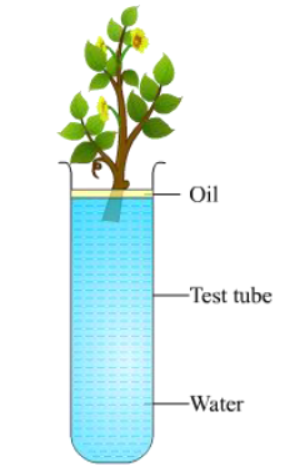
• Potometer Method: Potometer is a device used to measure water intake by a plant; this intake is equal to the water loss through transpiration. There are a number of designs of potometer that are used to measure transpiration. Some examples include Farmer’s potometer and Ganong’s potometer (to measure rate of water intake), Darwin’s potometer (to demonstrate the suction force created by transpiration), Garreau’s potometer (to demonstrate unequal transpiration from both the surfaces of a dorsiventral leaf), etc.
Let us understand the working of a Ganong’s potometer.
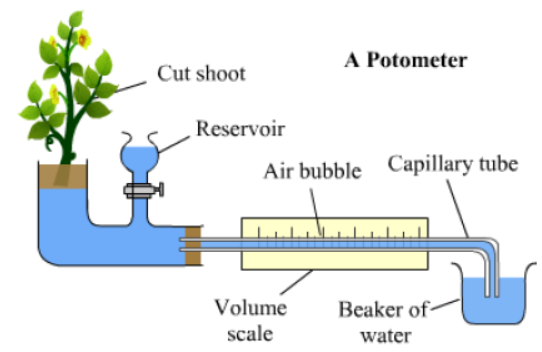
• Take a small twig of a plant, cut it and fix in the apparatus. Fill the apparatus with water. Introduce an air bubble in the horizontally graduated capillary tube which is dipped into a beaker containing water.
• As the twig looses water, a suction force is set up which pulls the water from the beaker and the bubble moves along. The readings on the capillary tube gives the volume of water lost in the given time by transpiration. The air bubble can be brought back to its original position by releasing some water from the reservoir by opening the stop cork.
Limitations of using potometer:
• Introducing the air bubble is not an easy task.
• The twig can die after sometime.
• Changes in outside temperature can affect the position of air bubble in the capillary tube.

We hope the above Transport in Plants Class 11 Biology are useful for you. If you have any questions then post them in the comments section below. Our teachers will provide you an answer. Also refer to MCQ Questions for Class 11 Biology


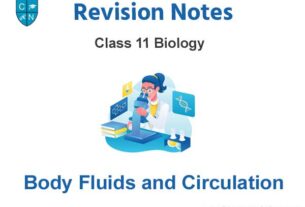
The information obtain on this page is very useful .